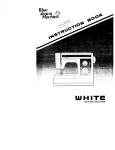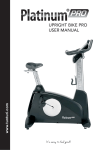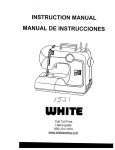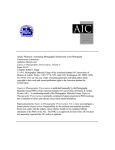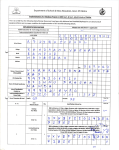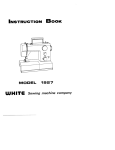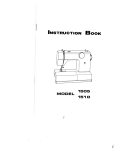Download White 1781 User's Manual
Transcript
I CD Cb) CD C,) m E z I m 0 0 w0 z 0 0 -l C 0 z POLARIZED PLUG CAUTION To reduce the risk of electric shock, this appliance has a polarized plug (one blade is wider than the other). This plug will fit in a polarized outlet only one way. if the plug does not fit fully in the outlet, reverse the plug. If it still does not fit, contact a qualified electrician to install the proper outlet. Do not change the plug in any way. SEWING MACHINE Record in space Provided below the Sedal No. and Model No of this appliance. The Serial No is located Rear of arm, The Model No is located Rear of arm Serial No._ Model No. 1899 1781 Retain these numbers for future reference. - Foot Controller Type: YC-482 IMPORTANT SAFETY INSTRUCTIONS when using an electrical appliance, basic safety precautions should always be Plowed, including the following: Read all instructions before using (this [ppliance). DANGER——To reduce the risk of electric shock: n appliance should never be left unattended when plugged in. Always unplug this pliance from the electric outlet immediately after using and before cleaning. WARNING——To reduce the risk of burns, fire, lectric shock, or injury to persons: Do not allow to be used as a toy. Close attention is necessary when this appliance is used by or near children. Use this appliance only for its intended use as described in this manual. Use only attachments recommended by the manufacturer as contained in this manual. Never operate this appliance if it has a damaged cord or plug, if it is not working properly, if it has been dropped or damaged, or dropped into water. Return the appliance to the nearest authorized dealer or service center for examination, repai electrical or mechanical adjustment. Never operate the appliance with any air openings blocked, Keep ventilation open ings of the sewing machine and foot controller free from the accumulation of lint, dust, and loose cloth. Never drop or insert any object into any opening. Do not use outdoors. Do not operate where aerosol (spray) products are being used or where oxygen is being administered. To disconnect, turn all controls to the off (“0”) position, then remove plug from outlet. Do not unplug by pulling on cord. To unplug, grasp the plug, not the cord. DANGER • Always unplug before relamping. Replace bulb with same type rated 15 watts. Do not reach for an appliance that has fallen into water. Unplug immediately. Do not place or store appliance where it can fall or be pulled into a tub or sink. Do not place in or drop into water or other liquid. WARNING 1. 2. 3. 4. 5. 6. 7. Keep fingers away from all moving parts. Special care is required around the sewing machine needle. Always use the proper needle plate. The wrong plate can cause the needle to break. Do not use bent needles. Do not pull or push fabric while stitching. It may deflect the needle causing it to break. Switch the sewing machine off (“0”) when making any adjustments in the needle area, such as threading needle, changing needle, threading bobbin, or changing presser foot, etc. Always unplug sewing machine from the electrical outlet when removing covers, lubricating, or when making any other user servicing adjustments mentioned in the instruction manual. Never operate on a soft surface such as a bed or couch where the air openings may be blocked. SAVE THESE INSTRUCTIONS CONTENTS 1 NAMES OF PARTS 2. ACCESSORiES 3. BEFORE SEWING Detaching Extension Table Connecting Foot Controller and Power Cord Changing Needle Changing Foot Bobbin Winding Inserting Bobbin Adjusting Lower Tension Drop Feed Lever Threading Upper Thread Twin Needle Threading Decorative Tucks or Designs Drawing Up Lower Thread Foot Pressure Fabric. Thread and Needle Table Pattern Setting 4. STRAIGHT SEWING Pattern Selection Dial Stitch Length Dial Starting to Sew Double Presser Foot Lifter Cloth Guide Adjusting Thread Tension Applications of Straight Stitch 5. ZIGZAG SEWING Zigzag Width Control Needle Position Control Thread Tension for Zigzag Stitch 6. MAKING BUTTONHOLES Determine Length Determine Width Left and Right Side Balance of Buttonhole Cutting Buttonhoies Corded Buttonholes 7. SEWING ON BUTTONS 8 OVERCASTING 9. OVERLOCKING Applications of the Elastic Overlockstitch Application of Ultra Stretch Application of RickRack Application of Decorative Fun P atterns 0. BLIND HEM STITCH. Elastic Blind Hem Stitch 1. STRETCH SEAM 2. ZiPPER SEWING 3. SHELL STITCHING 4. PIN TUCKING 5. QUILTING 6. SCALLOPING 1 MENDING Patching Mending a Rip 8. APPLIQUE WORK 9 EMBROIDERY ‘0. MAINTENANCE Cleaning Oiling ‘1 TROUBLE CHART Changing Light Bulb . . . . . . . . . . . . . . ... . - 2 3 4 4 5 6 7 8 .11 12 12 13 14 14 .... . . . . . . . . . . . . -- . . . . . . . . . . . . . . 16 17 18 •18 18 19 19 20 20 21 22 22 22 22 23 23 23 26 26 27 28 30 31 33 34 36 37 38 39 41 42 42 42 . .. . .. . 45 . . 48 0 C.) N) CD N) Li N) 0) N) N) - r’i N) N) 0 N) a) N) Ci] - 0) - CD 0 CD a) a) Ci] -J Q) Ci] C.) 4 C) N) N) - J • NAMES OF PARTS 1. 2. 3. 4. 5. 6. 7. 8. 9. 0. 1. 2. 3. 4. 5. 6. 7. Thread guide for bobbin winding Pressure regulator Take-up lever Face cover Upper thread tension dial Thread guide for upper threading Presser foot thumb screw Presser foot Free arm Shuttle cover Spool pins Pattern selection dial Stitch length dial Needle position control Reverse sewing lever Zigzag width control Drop feed lever 8. 9. O. 1. 2. 3. 4. 5. 6. 7. 8. 9. 30. Bobbin winding spindle Bobbin winding stopper Handwheel Stop motion knob Special buttonhole adjustment switch * Socket Thread guide for upper threading Handle Presser foot lifter Thread cutter Feed dog Needle plate * Specifications vary from country to country. 2. ACCESSORIES - Bobbins (3 pcs.) Felts (2 pcsl cc:::±: Needles Buttonhole toot Ordinary needles (3 pcs) __ ___ Ball Button sewing foot point needle 11 pc( Twin needle (1 pc.( Screw drivers Zipper foot (small) (large) Oiler Roll hemming foot Quilting guide Cloth guide Buttonhole cutter Accessories are stored in extension table. 3-- 3. BEFORE SEWING Machine is stored in flat-bed style which makes your work easier in ordinary sewing. Detachable Extension Table Slide table off and the machine is used as a free arm model. Free arm is convenient to sew or embroider; trousers, sleeves, cuffs of T-shirts, blouses, etc. Do vice-versa of above steps to attach extension table. To open lid of accessory box, push it open, as illustrated. 4 Connecting foot controller and power cord Connect foot power cord I controller and 2 Before plugging in your machine, be sure that voltage is same as that of your machine. (written on a plate at back of machine> Switch on put power on the machine and turn on the sewing light. a b h Push button to turn sewing light on and off. Always switch off or unplug machine when not in use. *Specifications vary from country to country. The more you press foot controller, the faster the machine runs. 5— Changing Needle Set needle in the highest position by turning handwheel towards you. Loosen needle clamp screw and remove needle. With flat face away from you, insert a new needle into groove of needle bar. Push needle until it reaches stopper a and tighten needle clamp screw firmly. Always use a straight needle with a sharp point. Proper needle straight shaft sharp point Using defective or worn needles not only causes stitch skipping, breakage of needles or snapping of thread; it also can damage hook and needle plate. -J 6— Changing Foot Raise presser foot lifter Set needle in the highest position by turning handwheel towards you 2 Snap-on Presser Foot: I, Push the lever a in the arrow direction so that the presser foot will come off Position a new foot with the pin b right under the groove of the holder Lower the presser foot lifter so that the foot will be automatically snapped on When you fail to catch the foot, push the lever in the arrow direction slightly a b Bobbin Winding Set needle in the highest position by turning handwheel towards you. Open shuttle cover. Open latch of bobbin case and take it out. —--- z I Close latch of bobbin case and bobbin comes out easily. —8— Push back to fold handle. Pull out spool pin and put a felt on spool pin. 4 1 Put a spool on spool pin. Draw thread from spool pin through thread guide and pre tension device, following numb ers and 2 4 2 I Wind thread clockwise around bobbin several times. Push bobbin on to spindle. Holding handwheel with your left hand disengage handwheel by unscrewing stop motion knob. L. —9— Push bobbin to right and press down foot controller. Machine stops automatically when bobbin is full. Push bobbin to left, to disengage from wheel. >N Take off bobbin and cut thread. from spindle Retighten stop motion knob. I If bobbin is wound unevenly as shown, open face cover and loosen set-screw of the guide for bobbin winding: Use screw driver to adjust height. trouble correction —10— inserting Bobbin I Place bobbin in its case with thread running in direction of arrow. ) Guide thread into bobbin case. slot a of Pulling thread to left, bring it under tension spring then to delivery eye .:. / I —11— Adjusting Lower Tension To test bobbin tension, hang and shake bobbin case as shown. At proper tension bobbin case gradually drop a small will amount. To adjust tension, turn adjusting screw with small screwdriver. loosen -J N Raise needle position. in the highest Leave end of thread of about 1 0 cm (4”) from bobbin case. Take hold of latch and push bobbin case into shuttle Release latch when bobbin case is fully inserted. DROP FEED LEVER The leier is in the right side of shuttle cover. For normal sewing, move the lever to A4 position. To lower feed dog, move the lever to AEA position. This position is used for button sewing, darning and embroidery. 1 2- Threading Upper Thread Raise presser foot lifter. Raise take-up lever to the highest position by turning handwheel towards you. Thread following numbers Pass thread through guide - 7 I Lead thread either side of tension disc 2 Hook it to guide 3 from down to upwards. 2 7 Thread take-up lever 4 Pass thread to guide 5 from right to left, and guide 6 (left one) then needle eye 7 Leave end of thread of about 1 5 cm (6”). 1 3— Twin Needle Threading Thread normal points the same wa threading, except and 7 in as at At point 2 pass threads sepa ratly to right and eft of tension d cc At guide 6 pass one of threads To right guide and the other at left quide At point 7 thread from right guide should be end to rqht needle eye and from left guide to left needle eye Leave ends of threads of about 1 5 cm (61 / Decorative Tucks or Designs Any stitch can be used with the twin needle for decorative effects Most attractive are the multiple stitch zigzag and blind hem stitch for fancy tucks. The satin stitch or tapered zigzag designs in two colors are effective for creative trims Caution: Remember to use no more than Z 5 zigzag width and needle post tion control at CD for twin needle sewing. Drawing Up Lower Thread Hold end of upper thread with left hand. . Turn handwheel slowly towards you until needle moves down and up again. :‘ Pull upper thread slowly and lower thread will be brought up in a loop. Pull out both threads to about 1 5 cm (6) and place them together under presser toot on left. Foot Pressure Push down the outer ring of the pressure regulator. This will re lease the pressure on the presser foot. To increase the pressure, push down inner pin until suitable pressure is obtained. Insufficient pressure may cause poor feeding of the fabric, skipped stitches, or difficulty in guiding the fabric. If feed dogs or presser foot marks appear on the fabric, reduce the pressure. When sewing multiple thickness or heavy fabric, reduce the pressure. Increase pressure when sewing lighter weight fabrics. —15— ibric, thread and needle table T4 5 °l C t’ E irop (‘elton C ottori 70 90 SHEER [on ( ‘nO.s No DEER 1 3iojsn Crepe wJr J’qondv. T feta 5 GOT i,A,TGHT C n Kr)TSde .J” CO ton Covered Polyester Slk Nyon Silk N eki Fi rope in USSze Port 705 iNst Style Reguar Do 3 9 60 Silk Nylon eS 70 9 30 50 SIk ‘S 80 11 iD 50 SIC 80 90 30 ra:y CCPOs 100 ‘6 30 Heavy Duty C C Poly ‘20 19 Sl y lee 7) 9 70 50 l)ninr Di XTRA H -AVY 1 ipholslery Canvas \Wfl eq 1 14 KM ES ,HT V’[lGHf Tricot lit 1FDlUM WEIGHT lersev Deible Knit ‘ow” Nt dAvy :1! VVEICHT Ne’ 80 70 lt 11) 80 NO VEolURS N,lio C C Poly C’CPoly Light 10 Medurr Bat 51k D’J-’ P’,yer ‘tKE FURS Si’k Nylon C C Pot, 0 1 1 14 ‘00 14 16 130 30 Med en ‘o Hea Bsll or ATHER JINYC S ElI MS 30 ll,HT TO MCD llM It El U H T 30 C C Poly Heave Duty CEACY LEATH-R 14 90 Wedqe C C Puly 90 100 13 16 Wedge C C Rely 100 110 16 18 Wedge 100 110 ‘6 18 Reqular 00 9 DECORATIVE TOUCHES SIC TOP STTCHlNG ‘AACHINE tMBR( DFR Iwist Sp 80 155 7) 1 6— REMARKS Looser op 3cr 1- cc one n to v - E0 JM Wool 51k 1 len velvetten. LotIon lil Terv’ /y flZ \ 4 Mer e’zed DLE: Nt T eRFAD 11 Rr’gulnr Pattern Setting tvW :z YELLOW 12 //A\V/A\V/A\\ 1 3 14 1 llA\V/A’A //A\V/A\V/A\\ 5 N N N ‘\ ‘ s. \ A A PURPLE RICK RACK PURPLE DECORATIVE PURPLE ULTRA STRETCH PUP PLE / 17 18 STRAIGHT STRETCH JLOCK PUP PLE OVERLOCK PuR:LE BR lAP PUP LE FISH PURPLE , AN -___ —17 - — 4. STRAIGHT SEWING Set machine as shown. ,i J4 0 Pattern Selection Dial Turn dial to choose pattern. Dial can be turned either to right or to left * Always make sure needle is in the highest position when operating dial -I Stitch length dial For a longer stitch, turn dial in clockwise. For a shorter stitch, turn it in counter-clockwise For normal sewing between 2 and 3. -18— it is set Starting to Sew Place fabric under foot about 1 cm (0.4”) inside the edge. Lower presser foot lifter. Important: Hold on both threads during the sewing of the first 3—4 stitches of the seam. Double Presser Foot Lifter In order to obtain winder gap when using very thick materials, firmly push presser foot lifter up as far as it will go. Reverse Sewing J 1’ To reinforce seam, sew back wards to the edge of fabric by pushing down reverse sewing lever. Release lever and commence forward sewing guiding fabric by hand as it is fed. Never pull material. \— 19— Cloth Guide Use cloth guide when sewing a long seam of regular distance from edge of material. Set guide in hole on arm, at right of needle plate, and adjust 111,1 3) distance. Run machine with edge of fabric touching guide. Position cloth guide at an angle to sew a curved seam. Sew reverse stitches for rein forcement at end of seam. Draw fabric to left when sewing is finished. Cut threads with thread Cutter behind presser bar. Adjusting Thread Tension a L [1!11F Test stitch performance on a scrap of material you are going to use. With correct tension (a). upper and lower threads tension is equal and strong enough to lock both threads in center If upper tension is too tight (loose), upper (lower) thread lies upper (lower) straight along surface of fabric ( h c Correct by turning tension dial . c:Th 20 Applications of Straight Stitch 4 A. Seams The normal stitch length for most fabrics is 3, but the length chosen should depend on the fabric and area of usage. Usually, heavier fabrics require longer stitches, and lighter weight fabrics require shorter stitches. For curved seams and bias cut areas use a shorter stitch length to add strength and elasticity to the seam. B. Basting/Topstitching Sewing a seam with a longer stitch is useful for temporary seams prior to fitting. Basting stitches also may be used when gathering in fullness. Topstitching can be done very effectively with the long straight stitch. For a bolder stitch, two threads of the same type can be threaded through one needle (size 14 or 16). A heavier thread such as buttonhole twist may beusedfortopstitching, but be sure to use a larger needle (size 1 6 or 1 8). Basting instructions in glossary. (J .5 4 C 0 - — AA \ —21 — .-) -/ 5. ZIGZAG SEWING Set machine as shown. ) To prevent seam ends unravell ing, set machine for straight stitch and sew in reverse at beginning and ending of seam. O34 :( f . 44 Zigzag Width Control ml Set control at required number. Larger the number, wider the stitch. Set it at 0 for straight sewing. c c Make sure needle is in upper position when you set control. D Positon s. Needle Position Control Ii Needle position can be changed position needle turning by control. .-- co s Loft t)O’,ItOfl button se in etc • Midibe position so Hqbt stit P buttonholes Pc ‘_) iqht position blind loon. OVeIlO( k right side When selecting position, make sure needle is in upper position to avoid tearing material or bending needle. Thread Tension for Zigzag Stitch Better.iooking zigzag stitching requires less upper tension than straight stitching. Loosen upper tension slightly. —22— _______ 6.MAKING BUTTONHOLES Set machine as shown. I 3-5 Determine Length I Measure diameter and thickness of button and add 03cm (1 8”) for bar tacks. Mark buttonhole size on material. marking 3cm(1 ‘8”> butonhole Determine Width s Ediameter__ L : I thickness Determine width according to diameter of button, its thickness, and kind of material. ) Attach buttonhole foot. Completely push back sliding part a of buttonhole foot. Place material under foot so that marking of buttonhole passes through center of foot and arrow b of foot indicates beginning line of marking. marking 23— -n . Bar tacking: Set pattern selection dial to 1 (:) and sew 5-6 stitches. Ur1, i Left side: Change pattern to 2 Sew left side from front to back until it reaches end line. (21]). --f 4N Remember the point where arrow shows so that it is not necessary to mark end lines for all buttonholes. N Bar tacking: Change pattern to 3 3) and sew 5-6 stitches. L” . : Right side: Change pattern to 4 ) and sew right side until it 4 ti catches first bar tack. ,, C Quick finish: To prevent unstitching, set zigzag width at 0 and proceed for a few stitches. 24— Left and Right Side Balance of Buttonhole I, Stitch density on right and left sides of buttonhole can be adjust by buttonhole balance control dial. This dial should usually be in a +“ neutral position (between and “— I If the stitches on the right side of the buttonhole are too close together, turn the dial to the left I> (+). *Turning dial to left opens right side and closes left side. = If the stitches on the right side of the buttonhole are too open, turn the dial to the right (—). *Turning dial to right closes right side and opens left side. I- + = Cutting Buttonholes Stick a needle through bar tacks to prevent over-cutting. Cut buttonhole along center with buttonhole cutter. Corded Buttonholes For stretch fabrics such as knits, a corded buttonhole is effective to keep finished buttonhole in shape. Hook filler cord on top spur and lead ends of cord under foot, pull taut, and hook them to bottom notches as shown. Proceed with stitching as for regular buttonholes. When buttonhole is completed, pull filler cord ends so that loop on the other end disappears into buttonhole stitching. Thread ends of cord to reverse side and tie, or cut both ends of cord. ... 7. SEWING ON BUTTONS Spt njchip s chnvi if C 25 . Position a button and material un der foot When needle comes to left side of stitch, lower fnot. Raise needle and adjust zigzag width so that needle comes to right hole of button Make c’ne stitch be certain that nec le is a’igned with button’s holes. Run machine at medium speed arid sew -6 zigzag stitches. / / 1 Stop machine when needle is in upper position. a Set zigzag w;dth control to 0. align needle with button’s hole and sew 3-4 stitches to prevent stitches from unlocking. OR b Remove work and cut off threads. Draw thread ends through to wrong side and tie a knot. 27 8. OVERCASTING For light weight material: Set machine as shown. Overcasting prevents edge of fabric from fraying and produces neat finish. 45 :._ N cz 44; Sew carefully so that all stitches on right side are flush with edge of fabric. - // // N For thick and elastic material: Set machine as shown. Sew in the same way above. —28— 9. OVERLOCKING it Overlocking stitches make t possible to sew and overcas seams at the same time. ( 4 Set machine as shown. a For medium, thin material b For medium, thick material Put two pieces of cloth together . with right sides facing and sew ing, To prevent edges from fray hes stitc sew so that right side l. eria mat drop outside the edge of overlocking In some cases for used be can stitches overcasting. —29--- Applications of the Elastic Overlockstitch This stitch is very effective for overcasting, edgestitching, etc. on knits and very stretchy fabrics, also, for decoration. Topstitching A decorative topstitch can be produced with the elastic edging stitch. Stitch around the structural lines of the garments for a dramat ic effect. Topstitch a braid or decorative inset with the elastic edging to add an additional decorative flair. Pattern: Length: 5 width: 5 Feed Dog: Up Pressure: Normal Foot: Embroidery Needle Position: L or R Edging As with the stretch blind hem, the elastic edging stitch can be used for a decorative edge on place mats, napkins and table cloths. Proceed as you would with the stretch blind hem stitch, but use the elastic edging stitch instead. Pattern :.Length: 5 Width: 3—5 Feed Dog: Up Pressure: Normal Foot: Embroidery Needle Position: M, L or A —30— Application of Ultra Stretch Stitch A. Seaming On most knits, a 3 1 6 inch finished seam, such as stitch and overcast or the overlock stitch, is more desirable than a 5/8 inch opened seam allowance. These stitches can create a neater, more profes sional finish, eliminate bulky seams prevent curling, permit the gar ment to “give” under stress, and at the same time they cut down on the amount of work involved in making a garment. If ever in doubt as to which of the two stitches to use, test both on the particular fabric in question and choose according to their perform ance. The stitch and overcast stitch is excellent for stretch fabrics such as sweater knits, bathing suit knits, and cotton knits. It has the greatest strength and elasticity of all. For patterns with 3 1 6 inch seam allowances: Feed the fabric such that the needle goes over the raw edge of the fabric when it swings to the right. For patterns with 5 8 inch seam allowances. Feed the raw edge of the fabric along the etched guide line “1 2”, then trim away the excess fabric close to the stitch ing. B. Procedure: •Overlock stitching is used for seaming and finishing the cut edge of knit fabrics, all in one operation. •This overlock sutch is especially good for stretch fabrics such as double knit and jersey ann will give a firm, neat edge finish, 14 S AA - -—--— ------ 31 - _ Application of Rick-Rack [\WIA\V/II J llI iii Zkr ) 0 B. Tapering/Rick-Rack The rick-rack stitch may be tape red to form creative stems and petals of flowers, embroidered pictures and wall hangings. As in tapering the zigzag, slowly turn the stitch width lever from 0 to 5 and back to 0. A group of these tapered rick-rack stitch will form a bouquet-like effect. C. Procedure: •The elastic rick-rack stitch is a zigzag line of stitching that is desired so that seams may be pressed open. .Apply this stitch to areas of stress on both wovens and knits. •Use narrow width of zigzag as a heavy duty triple stitch for seams. •Use medium and wide widths of zigzag for overcasting edges of seams, facings and hems of heavier weight fabrics such as terrycloth, and for attaching ela stic. Use also for decorative stitching. •Guide your fabric from the front. Do not pull or push as it will cause poor stitching. I 5 I EZ A. Topstitching/Rick..Rack A decorative topstitch can be the rick-rack produced with stitch. Stitch around the structural lines of the garment for a special effect. Topstitch braid or a deco rative inset to add an additional creative flair. - —32— __ Application of Decorative Fun Patterns [i LZ] L* A. Fun stitches-Swan-Fish-Briar The reverse stitch patterns pro duce swan, fish, briar designs for use on household linens and children clothes. These reverse stitch pattern can be used to sew in hems as the scallop stitch The reverse stitch patterns can also be used for topstitching bindings and ribbons for decorative effect. This is done in the same manner that lace is anpired with the zigzag stitch The straight stitched edge of the reverse stitch patterns on the left should be sewn on the left edge of the binding or ribbon. This decorative effect can be used on towels and placeniats for a pleasant appearance. The reverse stitch patterns can also be corded for stronger decorative edges en place mats and tablecloths. Simply place four strands of pearl cotton, em broidery floss or yarn under the presser foot A transparent foot will help guide the cord evenly while sewing the reverse stitch patterns The reverse stitch pat terns can he sewn with two threads through one needle for a more effective decorative stitch Simply thread two sewing threads through the upper threading system A larger needle should be used to accommodate the two threads. Use this decorative technique for enhancing tablecloths, placemats, napkins and curtains tI 1• ii EEE’ NOTE Narrow patterirs may be made by serting zigzag width to 432 33 10. BLIND HEM STITCH Set machine as shown. I 2.5 35 Fold material as shown and place it under foot, For a neater finish, it is preferable to baste or iron hem before hand. Sew carefully, so that straight stitches are made on hem edge, and slanting stitches pierce only one or two threads of fold. I - 34— _c:H:...!.. N a Correct seam b Needle is catching edge of fold too much. Needle is not catching edge of fold at all wrong side . b Elastic Blind Hem Stitch For elastic materials, set machine as shown and sew in the same way as for normal blind hem stitch 12 F 35 AA 35 __ 11. STRETCH SEAMS A balipoint needle is essential. Paper may be laid under knits for smoother feeding. 12 4 a Medium-weight fabrics double knit, jersey. 0 Apply elastic triple stitch. 4 b Light-weight fabrics Apply small zigzag. Reduce upper and lower thread tension. 1 0.5 0.5 I I.5[ —- c For Very elastic fabrics spandex (power net) Use lapped or abutted seam. Apply multiple zigzag. 0.5 1 :: cD —36-- 12. ZIPPER SEWING Set machine as shown. ) Used for dresses. blouses skirts, trousers, bags, etc. 23 0 By using the special zipper foot. zip per sewing can be easily done. (1) With right sides together tack along seam line of the opening a (2> Open the tacked seam and pull out the lower material O.3cm(¼’). Place the folded edge over the right side of the zipper and tack over it. (3) Replace the presser foot with the zipper foot on the left of the needle. The zipper foot can be shifted either to the right or the left of the zipper, so the zipper can be sewn without difficulty. Stitch from the bottom to the top. Remove the tacking. r 03cm (‘s 4 Turn the material to the right side. Ease the material and the zip per. Tack a measured 1 3cm (½’) from the tacked seam as a stiching guide. Shift the zipper foot to the right of the needle. Doublestitch across the lower end, then up along the zipper. Remove the tacking. (4’ —37-— wrong -i 13. SHELL STITCHING Silk, nylon organdy or similar sheer fabrics are suitable. /6 Set machine as shown. 2.5 3.5 - 5 Fold edge of material. With folded edge to left, place it under presser foot. 1 Pull thread ends towards back when starting sewing. Make sure needle misses raw edge of fold when it moves side ways. -I —38—- 14. PIN TUCKING Set machine as shown. sheer For better appearance, use ad thre er low material and tighten a little. g For twin needle threadin p. 14. see AA Insert the quilting guide under the spring plate on the holder. 4 } il or Mark first line with penc sew. tailor’s chalk, and sew, From second line, just g usin line first following seam of / guide. be Interval between seams can in e guid ing adjusted by mov direction of arrow. 3 9-. 15. QUILTING Set machine as shown. 4i 23 Baste layers of material to prevent them from slipping out as you sew. Attach quilting guide and sew in the same way as pin tucking. 40 16. SCALLOPING Set machine as shown. R L: Put two pieces of cloth together with right sides facing, and sew. Trim edge 0.3cm (1,8”) away from stitching. Make notches on seim edge at evenly spaced intervals. otches Turn two pieces to right sides out. Bring stitching line to very edge by pushing seam edge gently with your fingers, and press. . Push 41 17. MENDING Patching 8 Set machine as shown. > 3.5—5 .1 Place the patch over the worn part. Sew along the edge of the patch on the right side. Trim away the worn part close to the seam on back side I Mending a Rip Set machine in the same way as for patching. Sew the edges of tear together first. Then sew two more seams on either side. A piece of gauze can be placed jnderneath to reinforce the rip. —I -42- 18. APPLIQUE WORK Set machine as shown. 032 2.5 AA Draw design on material to be used as an applique and cut it out. Place cut-out on base material and baste it. / I I I Sew around outline with zigzag stitch adjusting stitch length and width according to shape and size of cut-out and type of base material. To change direction at corners or to sew very small circles, stop machine, positioning needle just away from edge of cutout, lift presser foot and turn material Lower presser foot and continue sewing Sew a few stitches at end with zigzag width at 0. This is to prevent unstitching. 43 ‘I 5 19. EMBROIDERY V Set machine as shown. 10’ Lj 4 - - Remove foot, and holder screw k To avoid lower thread being pulled up, reduce upper thread tension. - A Needle For good embroidery, it is important to use correct needles and thread. Thread No. 9 120 No. 11 100-80 No. 14 6050 --- 100 Use thin embroidery silk for upper thread and a thinner silk of same kind and color for lower thread. Trace your design on material and center it in embroidery hoop. Make sure material is taut. Pull out lower thread by turning handwheel towards you while holding upper thread lightly. Lower presser foot lifter. Hold both threads and start sewing along outline of design with satin stitch. Continue sewing guiding by hand. hoop To finish filling, sew several stitches with zigzag width at 0. Lay typewriting paper underneath when embroidering sheer fabric. —44— 20. MAINTENANCE t Your machine requires regular cleaning and oiling for satis factory sewing performance. A machine which is used for a few hours a day needs to be cleaned and oiled once a month. } Cleaning Remove foot and needle. Remove needle plate. Brush off all dust and lint on feed dog with cleaning brush. Turn latches outwards. Remove shuttle race cover. Remove shuttle Clean shuttle race with a cleaning brush and a soft cloth. Oiling Use oil manufactured specially for sewing machine use. Other cause eventually will oils mechanism to jam. Apply one drop of oil to part of shuttle where friction occurs. J Open face cover and apply oil in the same way. Be careful not to apply too much oil or it may stain your material and cause some sewing difficulty After oiling, run machine for 1-2 minutes to allow oil to penetrate to every part. Remove Top Cover: Puil out spool pins and push bobbin winding spindle to right. Loosening screws a and b with large screwdriver, then take off top Cover. arrows. )ly one drop of oil to lubricating points indicated by —46— 21. TROUBLE CHART PROBLEM Breaking lower thread Skipping stitches PROBABLE CAUSE bobbin Thread not wound evenly on the ctly corre or not drawn up Lower thread tension too tight inside Lint stuck in the bobbin case and the tension spring Needle not fully inserted Needle bent ad not Size or type of needle and thre rial mate the for suitable Incorrect upper threading Too much oil on the hook h equiJr stitches material Incorrect size of needle for the Upper thread tension too loose Incorrect lower tension The material not fed correctly CORRECTION P.10, P.15 P.12 Remove lint and fluff with a cleaning brush P. 6 P. 6 P.16 P13 P 46 P.16 P.20 P.12 ctly Pattern selection dial not set corre Incorrect feed dog height P.17 Lint stuck on the feed dog P.45 P.12 PROBABLE CAUSE PROBLEM The material puckers Upper or lower thread tension too tight P12, P.20 Stitch too long for material P.18 Thread too thick P.16 Incorrect threading of upper or lower thread Breaking needle CORRECTION P.13, P.11 Needle not correctly inserted P. 6 Needle bent P. 6 Needle clamp screw too loose P. 6 Upper thread tension too tight P.20 Needle too fine for the material P.16 Dials have been changed while the needle was down in the material P.18, P.22 Zigzag width set more than 2.5 while twin needle was attached P.14 trouble is still apparent in the machine,’ please consult your nearest dealer. o not try to correct fault by yourself. Changing Light Bulb Unplug the machine. Open face cover as shown. Remove bulb by unscrewing it in counterclockwise. Install a new bulb by screwing it in clockwise. 48—





















































